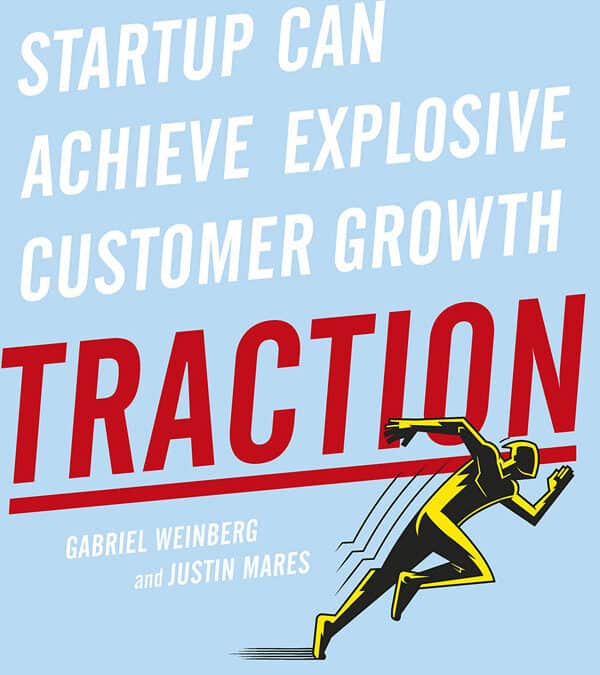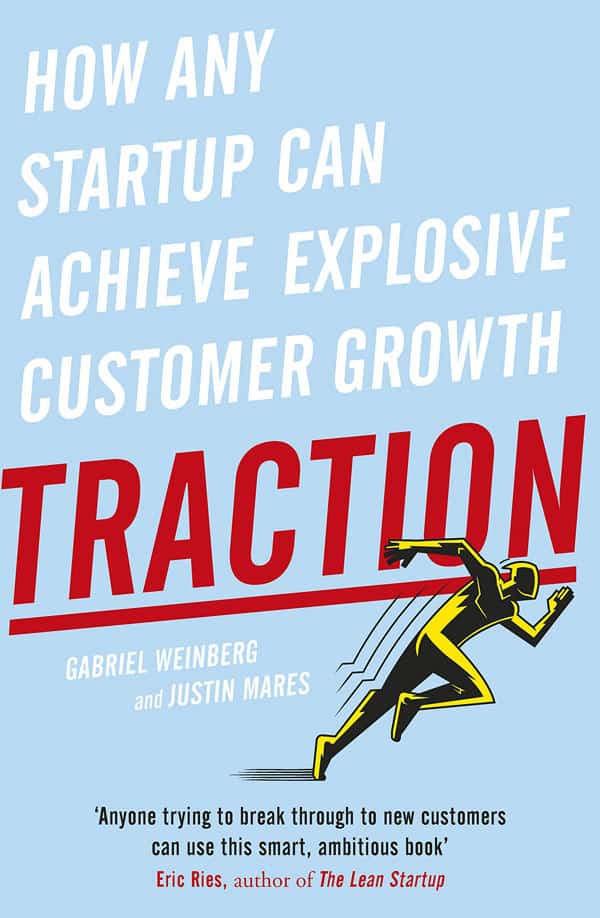Traction, A Startup Guide to Getting Customers by Gabriel Weinberg and Justin Mares
Recommendation
Entrepreneurs Gabriel Weinberg and Justin Mares interviewed 40 successful business founders to learn their promotion and advertising tips and to share them with you. They discuss how to use “traction” to draw customers by using 19 promotional “channels,” like public relations or search engine optimization. Many of their examples come from high tech, so web and software entrepreneurs will find this discussion particularly useful. Weinberg and Mares cover many topics, but they are going for breadth not depth. Their compendium could help you brainstorm new or replacement traction channels – but they don’t give sufficient data about any one channel to offer a how-to. Nevertheless, they do provide a pathway for seeing what’s out there, how others started their promotional journey, what inspiring new ideas they offer and how you can develop a traction strategy for your firm. getAbstract recommends this overview to entrepreneurs in start-ups and in ongoing businesses.
Take-Aways
- Getting “traction” means building your business by bringing in customers.
- Choose among 19 “traction channels,” that is, media and communication methods.
- Most companies fail because of bad distribution, not bad product, so getting even one channel right can bring you success.
- The only way to know if a particular traction channel will work for you is to test it.
- No traction channel performs forever, so keep checking new ones.
- Traction channels work differently during various phases of a firm’s growth.
- Many traction channels are online, including viral marketing, search engine marketing, social and display ads, content marketing, email marketing and blogs.
- Engineer specific tools to draw clients, like targeting relevant blogs and using existing platforms.
- Offline traction channels include public relations, unconventional PR, advertising, business development, and sales and affiliate programs.
- To increase your traction, attend trade shows and events, seek speaking engagements and build your community.
Traction Book Summary
Signs of Success
If your new company is starting to gain customers, you’re getting “traction.” In short, traction is an indicator of growth – the goal of every start-up. “Traction channels” are the sources of those customers. Entrepreneurs advise selecting among 19 different channels – that is, marketing paths – to spark success for your business or start-up. Most new firms focus only on familiar channels and ignore others, but you can’t know which channels will work for your firm unless you test the possibilities. Most companies fail due to bad distribution, not bad products, so getting one channel right can make the difference between a business that lasts and one that doesn’t.
But First, Hit the “Bullseye”
Trying to select among 19 different channels can seem overwhelming to an entrepreneur seeking traction. Start by using “the Bullseye Framework” to figure out what channels will do the best job of drawing customers to your firm.
“Traction is the best way to improve your chances of start-up success.”
The framework has five steps to repeat over and over:
- “Brainstorming” – Consider all the possible traction channels and the options in them.
- “Ranking” – Organize them by degree of potential success, most promising to least.
- “Prioritizing” – Pick a few of the most-likely-to-succeed channels, but not too many.
- “Testing” – Run tests cheaply to assess approximate client acquisition costs, the number of available customers and whether you want those particular customers.
- “Focusing” – Pay the most attention to the channels that work best. One of the available channels will dominate. Exploit it until it has nothing left to give.
“Good customer support is so rare that, if you simply try to make your users happy, they are likely to spread the news of your great product.”
Focus on marketing activities that “result in a measurable, significant impact.” Start-ups go through three phases: making something useful, marketing something useful and scaling the business so it grows. Activities that give your firm traction change from phase to phase.
Then, Find Your “Critical Path”
Selecting which prospective customers should get your attention is tricky. “Defining your critical path” will help you choose. To do so, set a traction metric, such as how many new clients you want or what percentage of your market to target. Your critical path should require the fewest steps that are necessary to attain your goal. Establish a main company path and multiple sub-goals (such as reaching a certain metric in a set amount of time) for different employees and departments. This will help you develop traction in as many channels as possible. As time goes on, marketing channels become less effective, so keep new ones available.
“Business development is like sales with one key distinction: it is primarily focused on exchanging value through partnerships, whereas sales primarily focuses on exchanging dollars for a product.”
Use the Bullseye Framework and define your critical path to make better use of these 19 traction channels:
- “Viral marketing” – Viral marketing convinces your customers to promote your firm and its offerings. Customer word of mouth draws on “inherent virality” – your clients are making a user invite other users before they try your product. (Various messaging applications use this tactic, often by making it possible for users to communicate only with other users). Make your product become more useful as a collaborative tool, which involves inviting other participants. Give users incentives to invite other people to join. Set your goals and measure everything when you launch your business. Follow the three-step “viral loop” process: Once users try your product or service, they tell other potential users and they, too, become users. To build a workable viral loop, draw lessons from your known successes. The “viral cycle” is the time a user takes to go through your viral loop; make it as short as possible. Improve one element at a time and then move on to the next. Cut out all unnecessary steps. Create as many opportunities as possible to send short invitations to potential customers. Conversion pages, which take someone from interested to committed, should echo the invitation’s message. You can grow exponentially with viral marketing, but success on this channel will prove hard to achieve and, ultimately, unlikely.
- Public relations – Garner coverage from magazines, newspapers and other traditional news sources. On the Internet, pitch small pieces to outlets where larger sources pick up information. Offer a brief, clear pitch with an emotional appeal to spark an editor’s interest. Publications heed milestones like funding rounds, product launches and industry alliances. Combine these events whenever possible.
- “Unconventional PR” – This approach includes publicity stunts and customer appreciation activities. You can use well-planned and well-executed stunts to gain instant national exposure, but they must be creative and smart. Try customer appreciation activities, like sending gifts, offering great support, or creating competitions and giveaways.
- “Search engine marketing” – Purchase key words in pay-per-click ad programs using Adwords and other search engines. The more competitive your key words are, the more expensive your ads will be. Google provides a quality score for each ad, ad group and campaign. A higher score, earns the ad a better placement. Create a list of key words, group them, create multiple landing pages and design no more than four ads. Test everything and improve the weaknesses your results reveal. Test with a small budget to see if a channel has potential. Consider advanced options, like advertising on Google’s Content Network, or using retargeting, scripts, negative key words or a “conversion optimizer.”
- “Social and display ads” – Ads on social media sites generate demand, but don’t harvest it. They enable you to create an atmosphere in which members of your target audience talk about your product. To spark this exchange, create compelling content. Understand your audience and test various messages. Most advertisers buy website display ads, like banners, in aggregate, often from networks like Google’s Display Network. To find ads that work for you, create similar, but not identical, key words and run multiple tests. Niche ad networks offer access to a particular, predefined demographic. Or, you can talk to the owner of a site you’ve targeted and ask if you can place an ad for a fixed monthly fee.
- “Offline ads” – Media outlets for your ads include TV, radio, various print options, billboards and direct mail. To develop an offline ad campaign, match a medium’s demographics with your target audience. Tracking results is more difficult offline, and requires using unique web addresses and promotional codes in each ad. Predicting what outlets are most effective is nearly impossible, so test them. Different media are better-suited for different ads. For instance, newspapers are good for reaching people older than 30 and for sharing time-sensitive offers and launches. A billboard has high visibility, but it’s hard for consumers who see it to take immediate action.
- “Search Engine Optimization” (SEO) – Improve your site ranking so search engines send more people to you. Consider whether you’ll be able to get on the first page of a topic’s search engine’s results. To gain more links, use PR, content marketing, shareable products and widgets that other site owners install to link back to your site. Your content must be so great that people want to link to it. Do not pay for links. Both of the two main SEO strategies, “fat head” and “long tail,” rely on content and links. Fat head calls for upping your rank on terms that describe your organization. To select key words to use, check their usage volume on Google’s Keyword Planner and narrow your list to a few. Google Trends can tell you how those terms perform. Open Site Explorer shows you how hard it is to earn a high rank for popular key words. Long tail means earning high ranking on specific, low-volume search terms by producing great content and multiple landing pages.
- “Content marketing” – Blogs beat ads because they keep on giving. Good blog content drives new customers. Some entrepreneurs start blogging before they have a product and use their blogs’ feedback to shape future products. Others don’t start blogging until after other sources of new clients dry up. Write about problems your clients face. Use guest blogging to build your audience.
- “Email marketing” – This is a personal traction channel: Your messages sit in users’ inboxes next to emails from their friends and family. This tactic works in all stages of a firm’s development. To build a list of active users, ask for email addresses at the end of your blog posts or offer a short, free download in your area of expertise in exchange for a prospect’s email address. “Lifecycle messaging” slowly exposes new users to your product’s features and reaches out to those who started but didn’t complete your purchasing process. Multistep email sequences result in higher conversion rates than immediate sales pitches. Marketing issues with email include deliverability and opening rates. Experiment with different sending times to see which gets the most attention. Make sure that your emails do not get marked as spam.
- “Engineering as marketing” – Create tools you give away to attract new customers. For instance, HubSpot’s “Marketing Grader” provides a potential customer with useful analytics; this gives the company a qualified lead. Such tools are “marketing assets with ongoing returns, rather than ads that result in a one-time boost.” Or create the tool and put it on a stand-alone website. The tool should give users demonstrable instant value with no strings attached, and be relevant to your business.
- “Targeting blogs” – Use search engines, social media, or conversations with people in your target audience to find the top blogs people read in your industry. You can offer bloggers a fee for showcasing your product. Create partnerships and exchange content with other bloggers.
- “Business development” – Derive value from establishing and growing relationships with other companies. These include standard cooperation with another organization to improve both of your products, joint ventures on new products, supply partnerships, and licensing and distribution deals. When you are building these relationships, always be clear about your company’s goals.
- Sales – This is the in-person process of converting leads into paying customers. Individual selling works best for more expensive products that call for hand-holding. Your company’s salespeople should focus their efforts on prospects who are ready to buy within a year. Your marketing department is responsible for those who need longer to commit to a purchase. Build a sales funnel and address any points at which prospects drop out before becoming paying customers. Keep customer needs in mind and make the buying process easy.
- “Affiliate programs” – This means paying a third party for leads, prospects, and the like. These programs include retail coupon and deal sites, loyalty clubs, prospect generation efforts, information products and lead generation. Your strategy depends on your willingness to pay to acquire clients, which works best with people with whom you already have relationships or through an established affiliate network. This is more cost-effective than pay-per-click ads, which you pay for no matter what.
- “Existing platforms” – These sites and app stores have customers you can leverage for traction. If your product is an app, use various channels, companies and techniques to promote it, including social sites and browser add-ons.
- “Trade shows” – Present your products in person to build demand, announce launches or sell to vendors. To decide if you want to participate in a particular show next year, attend this year as a guest. Set your goals for each show. Research the guest experts on the program and request meetings with them to capitalize on opportunities for face time with industry leaders. Host a dinner at a hot restaurant, split the costs with other firms and invite people you’d like to meet.
- “Offline events” – Create opportunities to aggregate your customers in one place and meet them in person. Host meet-up events, throw parties, attend someone else’s conference or create your own. These activities can be as simple or expensive as your time and budget allow.
- “Speaking engagements” – Give free talks to small groups. Reach out to event organizers and ask what they want speakers to discuss. Then pitch yourself, instead of the other way around. Build your reputation as a speaker. Tell the audience stories. Cover why you’re talking and what your message offers your audience. Practice. Generate social media attention before, after and during your talk.
- “Community building” – Develop relationships among your users. Work with your initial users to create a joint mission and facilitate cross-connections. Stay open and transparent, and members of your community will spark ideas for you.
“Always have a traction goal you are working toward.”
Company founders often wonder how much traction they need to lure investors. The more potential investors know about what you do and how well it works, the less traction they require before investing. As you seek growth, don’t quit too soon. Look for evidence of product engagement, however small. You may be ahead of your time.
About the Authors

Gabriel Weinberg, the founder of DuckDuckGo and Opobox, is an active angel investor. Justin Mares founded a number of acquired start-ups.



